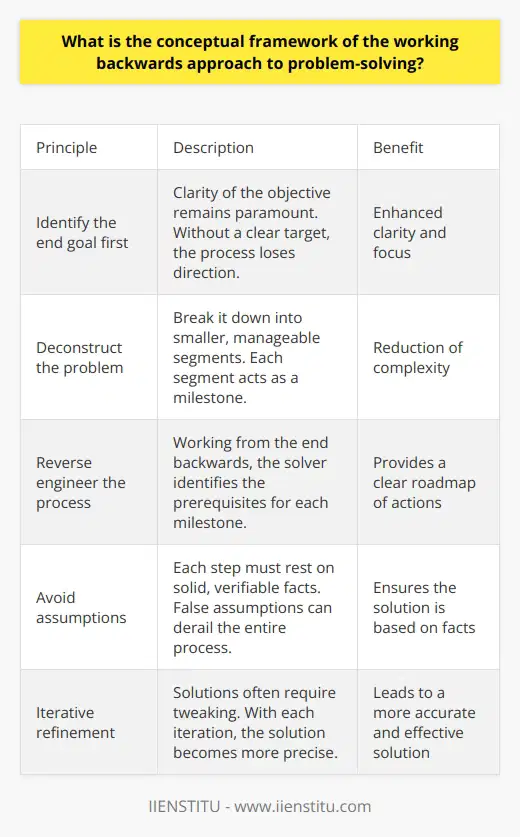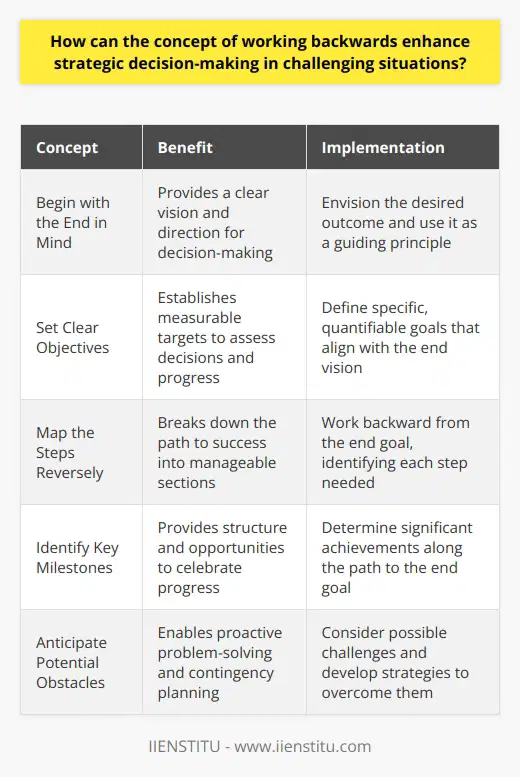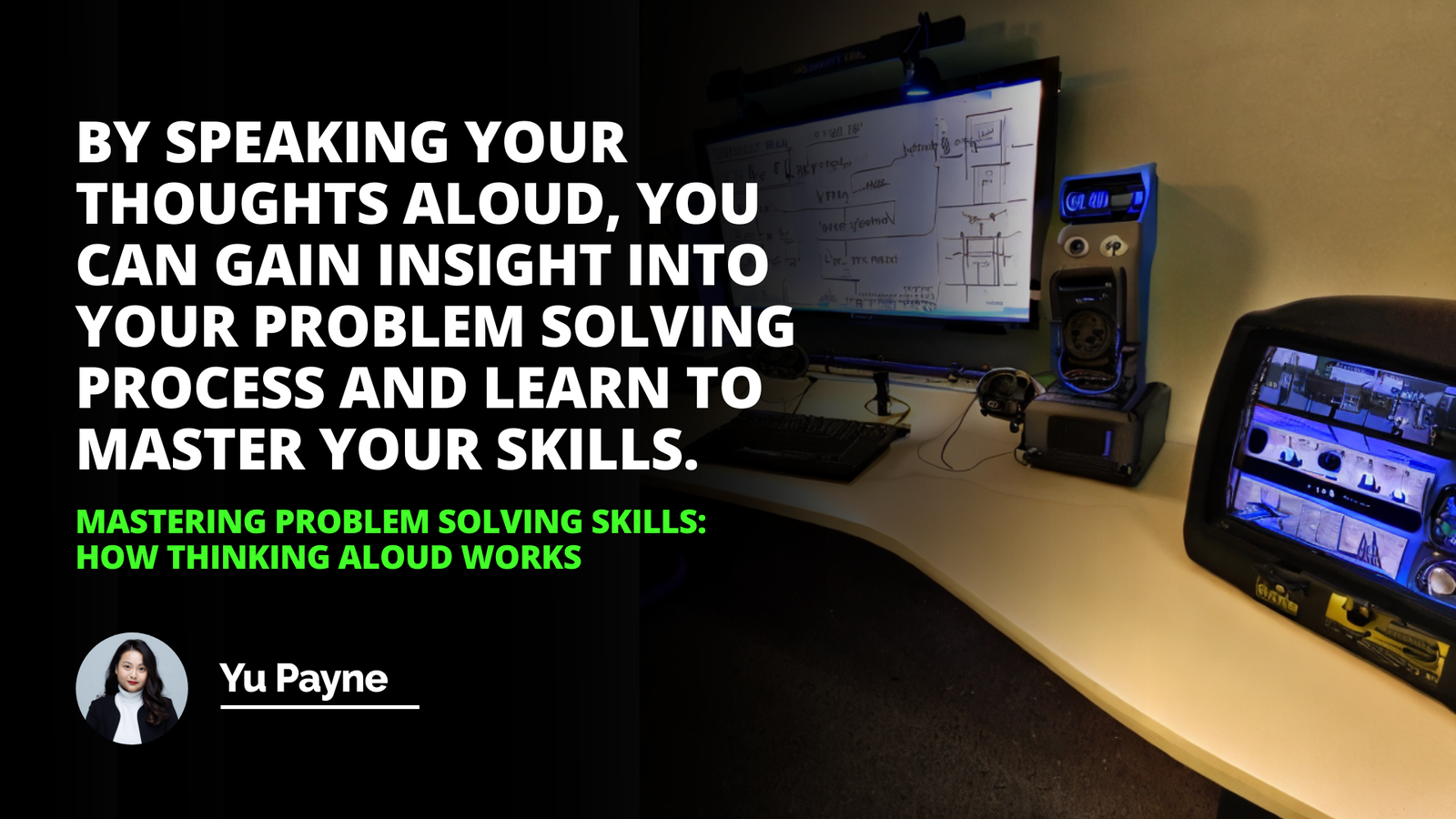
In the fast-paced and ever-evolving world we inhabit, challenges are as constant as the ticking of a clock. The Working Backwards Strategy is a beacon of hope amidst the formidable waves of complexity that confront individuals and organizations alike. In essence, this strategic approach is a clarion call to begin where most end – the desired outcome. By flipping conventional problem-solving on its head, this strategy empowers us to navigate through the murky waters of uncertainty and forge a clear path towards our goals.
The relevance of the Working Backwards Strategy can hardly be overstated - it imparts a robust framework to individuals and enterprises for overcoming challenges that may at first appear insurmountable. This article illuminates the intricate cogs and wheels that constitute the strategic approach to problem-solving, thereby equipping readers with an arsenal of tactics to conquer the obstacles that beset their paths.
As we embark on this enlightening journey through the annals of the Working Backwards Strategy, we will dissect its historical underpinnings, explore its mechanics, and glean insight from real-world applications. This expedition promises not just theoretical knowledge but also practical wisdom, aiding our understanding of how this approach dovetails seamlessly with innovative thinking to produce remarkable results.
The Genesis of Working Backwards Strategy
The Working Backwards Strategy is more than a mere tactic; it is a paradigm shift that has its roots firmly planted in a historical context. Its origin can be traced back to the stoic philosophers, who often emphasized the significance of visualizing the end to make sense of the present. Fast forward to the modern era, and we observe that this strategy has been honed and tailored to address the complexities of contemporary problems, particularly in business and technology.
Innovation has become the lifeblood of today's corporate giants and disruptive startups. The Working Backwards Strategy is paramount in this arena as it encourages an outcome-oriented outlook. When the endpoint is clear and immovable, the path to reach it can be crafted with precision and agility, aligning perfectly with the demands for creative and divergent thinking.
Not only does the strategy align with the forces of change propelling today's markets, but it also synergizes with the kind of innovative thinking that paves the way for groundbreaking advances. Even in a world that venerates forward-thinking, looking backwards from the future to the present offers the clarity needed to cut through the noise and home in on what truly matters.
Understanding the Mechanics of Working Backwards
Central to the Working Backwards Strategy are several core principles that guide its disciplined application. This strategy necessitates a departure from linear planning and proffers a more cyclic and iterative model of strategy development. It asks us to start with the customer experience and work our way to the minimum set of creative solutions needed to meet that experience.
Step 1: Identifying the ideal end-state
The inception of this journey demands a clear definition of the ultimate goal. This vision serves as a lighthouse, guiding all subsequent decisions and strategies. By envisioning the ideal end-state, one can crystallize their objectives and garner insight into the expectations that need fulfillment. Understanding the final destination is crucial as it underpins the entire process that follows.
Step 2: Establishing key milestones
Once a clear endpoint is discerned, the next phase involves charting out significant milestones. These act as checkpoints that help track progress and ensure that all efforts are congruent with the ultimate goal. Milestones define the critical junctures in the journey to success and lay out the high-level strategy that must be followed.
Step 3: Creating a reverse action plan
The creation of a reverse action plan is where the strategy takes tangible form. This plan draws directly from the identified milestones and sketches a backward path to the present. Each step is scrutinized through the lens of necessity and efficaciousness, with the primary criterion being its contribution to reaching the end goal.
This tactical phase is also where innovative thinking comes into full play. Understanding that the desired future state might require unprecedented solutions, practitioners of this strategy are encouraged to adopt an explorative mindset, entertain unconventional ideas, and remain adaptable in their approach.
Application in Various Contexts
Overcoming Challenges in Business Development
Example: Product development in tech companies
In the realm of technology, the strategy has proven instrumental in navigating the turbulent waters of product development. Take, for instance, the creation of a new software platform. Working Backwards entails envisioning the complete, seamless user experience before writing a single line of code. By focusing on the desired utility and ease of use, tech companies can reverse engineer the process to ensure each development phase contributes directly to the end user's needs.
Example: Marketing strategies in startups
For startups, crafting a marketing strategy can be a daunting task with resource limitations. Working Backwards from the client acquisition targets can help startups prioritize high-impact marketing efforts and optimize the allocation of their limited resources. This approach allows them to carve a niche in the market while ensuring sustainability and growth.
Problem-Solving Techniques in Personal Goals
Example: Career advancement planning
Working Backwards is not confined to the corporate and technological spheres - it's equally applicable to personal development areas such as career planning. By starting with the end goal of a desired job position, one can delineate the certifications, skills, and experiences required to achieve it. Opting for a problem solving course or an online mba course might emerge as pivotal steps in this tailored plan.
Example: Educational achievements
Students aiming for high academic achievement can also benefit from this strategy. By picturing their names on the dean's list, they can craft a detailed study schedule that revolves around this goal, carefully selecting the courses and extracurricular activities that align with their academic aspirations.
The Working Backwards Strategy has cemented itself as an essential component of the problem-solver's toolkit, offering a robust and strategic scaffold for surmounting challenges across a spectrum of domains. In reflecting on its utility, the strategy's penchant for fostering innovative thinking and meticulous goal orientation stands out as particularly compelling.
As we draw this exploration to a close, it becomes evident that the Working Backwards Strategy beckons individuals and organizations to re-evaluate traditional paradigms in favor of a more outcome-centric and proactive approach to problem-solving. It is a call to action, urging us to adopt this strategy with a view toward fostering innovation and strategic growth in our respective endeavors.
Now is the moment to harness the transformative power of the Working Backwards Strategy. Embrace this strategic approach in your professional pursuits, educational goals, or personal development plans. Tackle your current challenges with an innovative lens and backward vision. For those seeking to delve deeper into the intricacies of strategic problem-solving, resources abound; extending from literature to problem solving courses and online MBA courses designed to inculcate the principles of this efficacious strategy.
Equip yourself with the knowledge and tools necessary to convert your aspirations into achievements. Remember, the journey to success is often charted by looking to the end and crafting your pathway backward.
Frequently Asked Questions
What is the conceptual framework of the working backwards approach to problem-solving?
The Working Backwards Approach: A Conceptual Framework
The working backwards approach stands as a revered method in problem-solving. It starts with the desired outcome. This involves envisioning the ideal solution or end-point before anything else. After defining the end goal, one must then deconstruct it, breaking down the steps that lead to this outcome, in reverse. This retrospective path mapping distinguishes the working backwards strategy from other techniques.
Core Principles of Working Backwards
Identify the end goal first. Clarity of the objective remains paramount. Without a clear target, the process loses direction.
Deconstruct the problem. Break it down into smaller, manageable segments. Each segment acts as a milestone. Experts agree on the efficacy of this subdivision.
Reverse engineer the process. Working from the end backwards, the solver identifies the prerequisites for each milestone. This allows for a clear roadmap of actions.
Avoid assumptions. Each step must rest on solid, verifiable facts. False assumptions can derail the entire process.
Iterative refinement. Solutions often require tweaking. With each iteration, the solution becomes more precise.
Advantages of Working Backwards
- Enhanced clarity. Visualizing the end state brings focus.
- Reduction of complexity. Breaking down the problem simplifies it.
- Strategic insight. Recognizing dependencies becomes straightforward.
- Encourages creativity. Solutions may emerge in counter-intuitive ways.
Implementation in Different Fields
In software development, Amazon pioneered this approach. They write the press release before product development. Educators also apply this approach. They define learning outcomes before creating teaching plans. In research, scientists determine the desired discovery, then design experiments accordingly.
Challenges and Considerations
Resource constraints may limit the applicability. Adjusting the goal can sometimes be necessary. Solvers must remain cognizant of potential roadblocks. They might encounter stages where progression is not evident in reverse.
Theoretical Underpinnings
Cognitive science supports the working backwards method. It aligns with how the human brain problem-solves. The temporal structure of human cognition suggests a natural affinity for retrospective organization. Thus, working backwards proves not just effective, but intuitive.
The working backwards strategy offers a structured path to problem-solving. Begin with the end. Deconstruct to comprehend. Engage with facts. Refine rigorously. Recognize its potential across disciplines but remain aware of challenges. Anchored in cognitive theory, it mirrors our inherent reasoning processes. In sum, it presents a robust framework for tackling complex problems.

How can the concept of working backwards enhance strategic decision-making in challenging situations?
Working Backwards to Enhance Decision-Making
Strategic decision-making often involves complex problems. These problems can overwhelm decision-makers. When faced with such challenges, working backwards can clarify objectives and illuminate the path to achieving them.
Begin with the End in Mind
The mantra "begin with the end in mind" is central here. It compels leaders to envision the desired outcome first. This future state acts as a North Star, guiding all subsequent decisions and actions.
Set Clear Objectives
It is crucial to set clear, measurable objectives. These targets help assess decisions. They act as benchmarks throughout the process. Decision-makers can ensure alignment with the final goal by continually referencing these objectives.
Map the Steps Reversely
Mapping steps from the end goal to the present is a reverse chronology. This action breaks down the path to success into manageable sections. Each step becomes smaller, more tangible. It simplifies the process of identifying what actions to take and when.
Identify Key Milestones
Key milestones mark progress. They provide structure to the journey. Recognizing these milestones allows teams to celebrate small wins. This boosts morale and keeps focus sharp.
Anticipate Potential Obstacles
Working backwards forces foresight of obstacles. Anticipated issues can be tackled proactively. Solutions become embedded in the plan from the start.
Allocate Resources Wisely
Knowing the end goal helps allocate resources wisely. It becomes clear where to invest time, money, and effort. Scarce resources are conserved for critical paths.
Adjust with Flexibility
Even the best plans need adjustments. With a clear end goal, decision-makers can pivot with confidence. They remain flexible without losing sight of the objective.
Foster a Strategic Mindset
The backward approach fosters a strategic mindset. This thought process values proactive planning. It involves considering long-term impact over short-term gains.
Enhance Team Communication
Clear benchmarks improve team communication. Everyone understands the direction and their role in it. This alignment reduces misunderstandings and enhances collective performance.
Encourage Analytical Thinking
Working backwards encourages analytical thinking. Decision-makers must dissect the goal into its parts. They learn to understand the mechanisms that drive success.
Working backwards is not just a tactic. It is a strategic philosophy. It simplifies complex decision-making. Clarity, foresight, and structured planning are its byproducts. In challenging situations, this method can be a game-changer. Strategic leadership demands such innovative approaches. It stands as a testament to the virtue of thoughtful, reverse-engineered problem-solving.

Can you provide an example of how employing a "working backwards" strategy has been successful in a real life complex challenge?
The Virtue of Working Backwards
Success often stems from innovative strategy. Employing 'working backwards' illustrates this point. This approach demands starting from the end goal. One then maps out the path to that goal. This ensures efficiency and focus.
Consider Amazon's approach to product development. They start with customer needs. They create the press release first. This defines the desired outcome. They write about the product's release. This draft press release centers on the customer experience. It covers benefits and customer challenges. Amazon then engineers the product backwards. They develop features to fulfill the press release claims. This ensures the final product delights customers.
Real-Life Success Stories
This strategy thrives across various industries. Look at software development, for instance. Successful teams don't start coding immediately. They first define the user's end experience. Features then get planned. Every feature must serve the user's needs. Only after meticulous planning does coding begin.
Apple also embraces this mindset. They begin with the user experience. Product design comes next. Engineering follows to meet these specifications.
The 'Working Backwards' Framework
This strategy can be broken down into steps:
- Identify the ultimate goal.
- Craft the final outcome's narrative.
- Pinpoint essential success metrics.
- Develop milestones working backwards from the goal.
- Execute the plan, ensuring alignment at each step.
Critical Evaluation
While powerful, 'working backwards' is not infallible. It requires deep customer understanding. It demands that the end goal remains clear. Teams must adopt a customer-centric vision. Assumptions need constant testing. The strategy thrives on flexibility.
In summary, 'working backwards' breeds innovation. It demands a customer-first approach. It enforces clarity and focus throughout a project. Both Amazon and Apple showcase its success. Adopting this tactic means aligning with customer value. It ultimately leads to products that resonate in the market.


